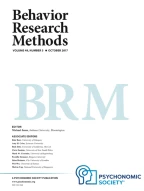Abstract
In the present article, we present a software package, MouseTracker, that allows researchers to use a computer mouse-tracking method for assessing real-time processing in psychological tasks. By recording the streaming x-, y-coordinates of the computer mouse while participants move the mouse into one of multiple response alternatives, motor dynamics of the hand can reveal the time course of mental processes. MouseTracker provides researchers with fine-grained information about the real-time evolution of participant responses by sampling 60–75 times/sec the online competition between multiple response alternatives. MouseTracker allows researchers to develop and run experiments and subsequently analyze mouse trajectories in a user-interactive, graphics-based environment. Experiments may incorporate images, letter strings, and sounds. Mouse trajectories can be processed, averaged, visualized, and explored, and measures of spatial attraction/curvature, complexity, velocity, and acceleration can be computed. We describe the software and the method, and we provide details on mouse trajectory analysis. We validate the software by demonstrating the accuracy and reliability of its trajectory and reaction time data. The latest version of MouseTracker is freely available at http://mousetracker.jbfreeman.net.
Article PDF
Similar content being viewed by others
Avoid common mistakes on your manuscript.
References
Abrams, R., & Balota, D. (1991). Mental chronometry: Beyond reaction time. Psychological Science, 2, 153–157.
Akamatsu, M., & MacKenzie, I. S. (2002). Changes in applied force to a touchpad during pointing tasks. International Journal of Industrial Ergonomics, 29, 171–182.
Dale, R., Kehoe, C., & Spivey, M. J. (2007). Graded motor responses in the time course of categorizing atypical exemplars. Memory & Cognition, 35, 15–28.
Dale, R., Roche, J., Snyder, K., & McCall, R. (2008). Exploring action dynamics as an index of paired-associate learning. PLoS ONE, 3, e1728.
Dietrich, E., & Markman, A. B. (2003). Discrete thoughts: Why cognition must use discrete representations. Mind & Language, 18, 95–119.
Farmer, T. A., Anderson, S. E., & Spivey, M. J. (2007). Gradiency and visual context in syntactic garden-paths. Journal of Memory & Language, 57, 570–595.
Finkbeiner, M., Song, J. H., Nakayama, K., & Caramazza, A. (2008). Engaging the motor system with masked orthographic primes: A kinematic analysis. Visual Cognition, 16, 11–22.
Freeman, J. B., & Ambady, N. (2009). Motions of the hand expose the partial and parallel activation of stereotypes. Psychological Science, 20, 1183–1188.
Freeman, J. B., Ambady, N., Rule, N. O., & Johnson, K. L. (2008). Will a category cue attract you? Motor output reveals dynamic competition across person construal. Journal of Experimental Psychology: General, 137, 673–690.
Freeman, J. B., Pauker, K., Apfelbaum, E. P., & Ambady, N. (2010). Continuous dynamics in the real-time perception of race. Journal of Experimental Social Psychology, 46, 179–185.
Gold, J. I., & Shadlen, M. N. (2001). Neural computations that underlie decisions about sensory stimuli. Trends in Cognitive Sciences, 5, 10–16.
Goodale, M. A., Pelisson, D., & Prablanc, C. (1986). Large adjustments in visually guided reaching do not depend on vision of the hand or perception of target displacement. Nature, 320, 748–750.
Magnuson, J. S. (2005). Moving hand reveals dynamics of thought. Proceedings of the National Academy of Sciences, 102, 9995–9996.
McKinstry, C., Dale, R., & Spivey, M. J. (2008). Action dynamics reveal parallel competition in decision making. Psychological Science, 19, 22–24.
Newell, A. (1980). Physical symbol systems. Cognitive Science, 4, 135–183.
Pylyshyn, Z. W. (1984). Computation and cognition. Cambridge, MA: MIT Press.
SAS Institute (1989). SAS/STAT user’s guide. Cary, NC: Author.
Schmidt, T. (2002). The finger in flight: Real-time motor control by visually masked color stimuli. Psychological Science, 13, 112–117.
Song, J. H., & Nakayama, K. (2006). Role of focal attention on latencies and trajectories of visually guided manual pointing. Journal of Vision, 6, 982–995.
Song, J. H., & Nakayama, K. (2008). Target selection in visual search as revealed by movement trajectories. Vision Research, 48, 853–861.
Spivey, M. J. (2007). The continuity of mind. New York: Oxford University Press.
Spivey, M. J., & Dale, R. (2004). The continuity of mind: Toward a dynamical account of cognition. In B. H. Ross (Ed.), The psychology of learning and motivation: Vol. 45. Advances in research and theory (pp. 87–142). San Diego: Elsevier.
Spivey, M. J., & Dale, R. (2006). Continuous dynamics in real-time cognition. Current Directions in Psychological Science, 15, 207–211.
Spivey, M. J., Grosjean, M., & Knoblich, G. (2005). Continuous attraction toward phonological competitors. Proceedings of the National Academy of Sciences, 102, 10393–10398.
Spivey, M. J., Richardson, D. C., & Dale, R. (2008). The movement of eye and hand as a window into language and cognition. In E. Morsella, J. A. Bargh, & P. M. Gollwitzer (Eds.), Oxford handbook of human action (pp. 225–249). New York: Oxford University Press.
Tipper, S. P., Howard, L. A., & Houghton, G. (1998). Action-based mechanisms of attention. Philosophical Transactions of the Royal Society B, 353, 1385–1393.
Wojnowicz, M. T., Ferguson, M. J., Dale, R., & Spivey, M. J. (2009). The self-organization of explicit attitudes. Psychological Science, 20, 1428–1435.
Author information
Authors and Affiliations
Corresponding author
Additional information
The research reported in the present article was supported by Research Grant NSF BCS-0435547 given to N.A.
Rights and permissions
About this article
Cite this article
Freeman, J.B., Ambady, N. MouseTracker: Software for studying real-time mental processing using a computer mouse-tracking method. Behavior Research Methods 42, 226–241 (2010). https://doi.org/10.3758/BRM.42.1.226
Received:
Accepted:
Issue Date:
DOI: https://doi.org/10.3758/BRM.42.1.226
